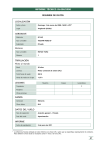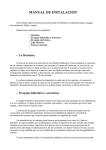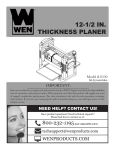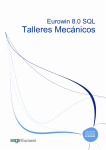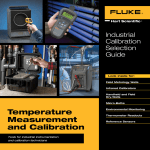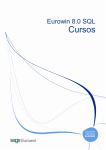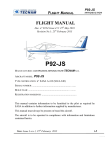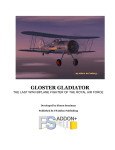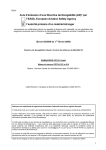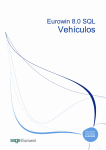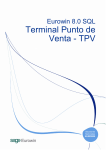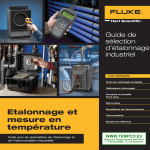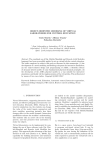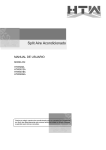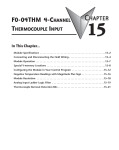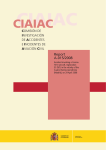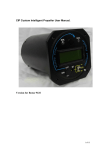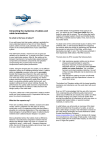Download 181 REPORT IN-006/2008 LOCATION FLIGHT DATA REPORT
Transcript
REPORT IN-006/2008 DATA SUMMARY LOCATION Date and time Sunday, 2 March 2008; 16:30 UTC1 Site Anglesola (Lleida) AIRCRAFT Registration EC-JLQ Type and model TECNAM P2002-JF Operator Private Engines Type and model ROTAX 912S2 Number 1 CREW Pilot in command Age 26 years old Licence Commercial Pilot License (CPL) Total flight hours 283 h Flight hours on the type 11.5 h INJURIES Fatal Crew Serious Minor/None 1 Passengers Third persons DAMAGE Aircraft Minor Third parties N/A FLIGHT DATA Operation General Aviation – Private Phase of flight Approach REPORT Date of approval 1 9 June 2011 All times in this report are in UTC unless otherwise specified. To obtain local time, add one hour to UTC. 181 Report IN-006/2008 Addenda Bulletin 4/2011 1. FACTUAL INFORMATION 1.1. Description of event On 2 March 2008, the pilot was flying from Sabadell to Pamplona to Sabadell (LELL-LEPPLELL) onboard aircraft TECNAM P2002-JF, registration EC-JLQ. It was the aircraft’s first flight of the day and, as reported by the pilot, the pre-flight inspection and engine test had been satisfactory and the flight to Pamplona had been uneventful. Once in Pamplona, both the pre-flight inspection and the engine test were again satisfactory, the only difference being that the oil level dipstick indicated 1/4 instead of 1/2 (as found on the pre-flight inspection at the aerodrome of origin), as a result of which the pilot filled the oil tank. About an hour into the return flight to Sabadell, the oil pressure started to drop until the oil pressure reading was at the lower threshold of the green region (2 bars) (see Figure 1). The remaining parameters were within limits. A few minutes later, the engine started to sputter and lose power. The oil pressure reading dropped below 2 bars (upper threshold of yellow region). According to his statement, the pilot then performed the emergency procedure2, but the engine did not regain power; instead, the propeller stopped completely two minutes later. Unable to restart the engine, the pilot declared the emergency to the Barcelona Control Center (BCN), selected an emergency frequency on the transponder and then conducted an emergency landing west of Tárrega (Lleida). Figure 1. Cockpit oil pressure indicator Figure 2. 2 The pilot was uninjured and the aircraft, except for the engine, was undamaged. Final position of aircraft in field where it landed According to the Flight Manual, the low oil pressure emergency procedure involves checking the oil temperature and, if rising, instructs the pilot to position the throttle so as to attain 68 KIAS (maximum efficiency speed) and to land as soon as possible. In case the engine stops, the pilot is instructed to attempt to restart it and, failing that, to execute an emergency landing. 182 Addenda Bulletin 4/2011 1.2. Report IN-006/2008 Personnel information The pilot was in possession of a valid and in force commercial pilot license and medical certificate. According to his flight log, he had a total of some 283 h of flight experience, of which 11.5 had been on the type. 1.3. Aircraft information The TECNAM P2002-JF aircraft, registration EC-JLQ and S/N 021, is a single-engine twoblade low-wing aircraft with a fixed landing gear. It is classified as a very light airplane (VLA) and has a maximum takeoff weight (MTOW) of 580 kg. The aircraft was rented out to individuals and flight schools by TOP FLY. The aircraft’s onboard documentation was complete and up to date. The aircraft was outfitted with a ROTAX 912 S2 four-cylinder engine, S/N 4922787. According to the engine logbook, it had been installed on the aircraft with 459:54 h of operation and had an estimated 1,325 h at the time of the incident. The fuel used on the aircraft was AVGAS 100LL. Even though the manufacturer recommends the use of unleaded fuel, AVGAS 100LL can also be used, though with some restrictions, such as greater inspection frequencies. The manufacturer also warns of increased carbon deposits on the pistons and the premature wear of the valve seats. The engine log noted that the overhaul was due after 1,200 h. According to the aircraft’s maintenance program, the technical documentation to be used for maintaining the engine was the Maintenance Manual, Edition 0, with the overhaul due after 1,500 h instead of 1200. This increase in the TBO (time between overhauls) had been established, depending on the engine’s serial number, in SB-912-041. Said extension was applicable only if a special inspection had been performed after 800 h, which had not been done in this case. In the same Service Bulletin there was a note that read: All engines of type 912S (series) need to receive an inspection of the propeller gearbox at 800 hours TSN3. If a TSN of 800 hours has already been completed, the check must be done at the next 100-hour inspection... At the time of the incident the aircraft had 1,325 h, about the same as the number of hours on the engine. The 1,200-hour overhaul had been carried out in November 2007. The last inspection (100 hour) had been performed with 1,300 h. 3 TSN – Time Since New. 183 Report IN-006/2008 1.4. Addenda Bulletin 4/2011 Investigation 1.4.1. Engine inspection The engine was disassembled as part of the investigation. During the inspection it was noted that the intake and exhaust valves on the number 2 cylinder (front left, as seen from the cockpit) had fractured, perforating the piston and damaging said cylinder’s head (see Figure 3). Figure 3. Condition of piston and no. 2 cylinder head Dents were also observed inside the intake manifold for the enumbered cylinders. The top plate (spring retainer) was also broken on the exhaust valve and there were metal shavings on the magnetic plug in the sump (see Figure 4). Figure 4. Both valves were fractured where the stem joins the valve head. There is no specific mention of a valve inspection in Folder 05-20-00, Scheduled Maintenance, of the line Maintenance Manual. 184 Addenda Bulletin 4/2011 Report IN-006/2008 In the Advanced Engine Maintenance Manual, Section 3.11.5, on valves, there is a reference to the fact that if carbon deposits accumulate on the valve stem, this is symptomatic of valve overheating and warns of the risk of fracture in the area where the head and the stem meet. As a result, guidelines are established for checking the valves and replacing them if necessary. In this case, the state in which the valves were found did not allow for a determination of whether carbon deposits had built up on the stem. Deposits were noted, however, on the piston heads of other cylinders, this being the area where most carbon deposits occur in engines that burn oil and have exceeded about 80% of their useful life. 1.4.2. Considerations on useful engine life According to the User Manual, AVGAS can be used to power the engine, though the manufacturer warns that due to the high lead content of AVGAS, there would be increased wear on the valve seats and more deposits in the combustion chamber and sediments in the oil system. As a result, it recommends using AVGAS only if there are problems with vapor lock or if other fuel types are not available. Of note is the fact that the last revision of Service Instruction SI-912-016 on selecting suitable fuel must be followed. As for the lubricant, the manufacturer instructs to use only oil that is classified as API “SF” or “SG”. Another notice in the User Manual states that if the engine is run primarily using AVGAS, then more frequent oil changes will be required, referring again to SI-912-016. The most recent SI-912-016 at the time of the incident was dated 28 August 2006, and specified the following items, among others: 3) Lubricants • If possible, operate the listed engine types using unleaded or low-lead fuel (AVGAS 100 LL is not considered low leaded in this context) • Use the motor oils listed in Section 3.3 of this Instruction. • Use only oil with API classification “SG” or higher. • [...] • In case of severe operating conditions (i.e. flight school), the time between maintenance intervals must be generally shorter and in particular, the frequency of oil changes must be increased regardless of the fuel type used. 3.3) Operation with leaded AVGAS fuels If the engine is mainly operated with leaded AVGAS fuels, the following maintenance operations are necessary in addition by latest after every 50 operating hours: 185 Report IN-006/2008 • • • • Addenda Bulletin 4/2011 Change of oil filter Change of engine oil Oil level checks, etc., according to the most recent Maintenance Manual. [...] NOTE: when operating primarily on leaded AVGAS fuel, it is recommended that the engine oil be changed every 25 operating hours. More frequent oil changes will assure the timely removal of residues and oil sludge, thus avoiding increased wear or operating problems. The manufacturer next lists a series of recommended oils, as well as other oils which are not recommended. 3.4) Motor oils not suitable for engine types 912/914 Series Experience has shown that only some oils are suitable for use in ROTAX engine types 912/914. Careful selection is advised following the recommendations in this Service Instruction. [...] ROTAX is aware of formulation changes to some oils previously recommended for use in these engines. As a result, ROTAX no longer recommends the use of these oils. It is not known what type of lubricant was used in the engine. 1.4.3. Aircraft and engine operation and maintenance The aircraft and engine documentation provided (Aircraft Logbook and Engine Log) reveal that the engine, S/N 4922787, had previously been installed on another aircraft with the same characteristics. According to the Engine Log, the engine, S/N 4922787, was installed with 459:54 h and 600 aircraft hours on EC-JLQ on 29/03/2007. The log’s entries regarding the number of hours the engine was in operation in the aircraft of origin are incomplete. There are no entries for the operating hours once it was installed on the incident aircraft. In addition, the number of hours the engine was run in the two aircraft are inconsistent, since there are entries for engine inspections conducted with 459:54, 512:18, 554 and 604 aircraft hours in the log for the engine while it was still installed in the aircraft of origin. The first engine inspection entry in the incident aircraft was at the 643-hour point. There are no entries regarding the performance of maintenance activities, if any, until following its installation on the incident aircraft. 186 Addenda Bulletin 4/2011 Report IN-006/2008 The 100-hour inspection at the 1,100-hour mark was not logged, so presumably it was not completed. The work orders referenced in the inspection entries were not provided to investigators for analysis, so it is not known what tasks were actually completed during each inspection. Also unknown are any relevant details, such as the type of lubricant used. The various inspections had been conducted at different Maintenance Centers. The engine was scheduled for an overhaul at 1,500 h, according to the approved maintenance program and to SB-912-041, which increased the TBO for certain engines, including the one installed on the incident aircraft. A note was included stating that the special inspection at the 800-hour mark4 was required. Said inspection was not listed as having been done on the Engine Log. The overhaul was in fact completed with 1,200 h, as reflected in the Engine Log. Neither the 25-hour inspections recommended by the manufacturer following the overhaul (done at 1,200 h) nor the oil changes every 25 hours stemming from the use of AVGAS 100 LL (as per SI-912-016) had been completed. The last inspection noted in the Engine Log was the 100-hour inspection, done with 1300 hours on the aircraft. The Maintenance Center, belonging to an ULA flight school, usually performed the ultralight aircraft maintenance. It was authorized by AESA (State Agency for Aviation Safety), with national license number 192, to practise as maintenance center with aircraft types Tecnam P92J-01, P92JS, P-2002-JF & P-2002-JR, and their engines, propellers, instruments and accessories. As of the ending date of this report, this maintenance center is in the process of being closed. There is no record that the operator, TOP FLY, monitored the continued airworthiness of the aircraft. 1.4.4. Inspection of intake and exhaust valves and of piston on the affected cylinder (No. 2 cylinder) The affected cylinder components were sent to a materials laboratory for physicalchemical, metallographic and fractographic analyses. These checks revealed that the materials of the components analyzed complied with the manufacturer’s specifications. The conclusion drawn from all of the analyses carried out on the components is that a 4 The propeller gearbox on all engines of the 912 S (Series) type must be inspected at 800 h TSN. If an 800-h TSN inspection has already been completed, the gear must be checked during the next 100-hr inspection. 187 Report IN-006/2008 Addenda Bulletin 4/2011 foreign element must have been present in the space between the piston and cylinder head that could have interfered with the movement of the elements comprising the cylinder-piston assembly. After analyzing the different parts sent for inspection, this foreign element was determined to have belonged to either an exhaust valve or the seat of said valve, and which lodged in the cylinder head. Said element would eventually also have caused the exhaust valve to fracture. 2. ANALYSIS AND CONCLUSIONS According to the Aircraft Logbook, the engine, S/N 4922787, had been installed on 29/03/2007 with 459:54 h and 600 total hours on the aircraft. The Engine Log listed several engine inspections prior to the date of its installation on aircraft EC-JLQ. The last of these was an inspection done with 604 aircraft hours on the aircraft of origin and 643 aircraft hours on the incident aircraft, meaning that despite the discrepancies in the entries, both the hours on the engine and on the incident aircraft, and thus the inspections done, coincided from that moment on (600 h). It is unknown, however, whether the engine was otherwise maintained and how the engine inspections could have been completed on one aircraft while it was supposedly installed on another. In general, the entries pertaining to the aircraft inspections performed were either incomplete or non-existent. Some engine hours were also not annotated in the Engine Log. This reflects a lack of organization in terms of document management, and hampers efforts to trace aircraft components. It can also result in confusion when attempting to determine what inspections might be applicable to the aircraft or engine, even if the number of hours between them do coincide, as in this case. In addition, the manufacturer had warned that the routine use of leaded AVGAS fuel causes premature wear of valve seats, increased carbon deposits on the pistons and premature oil degradation. As a result, the manufacturer recommends that when using said fuel types, the engine inspection period be shortened, along with that for replacing the oil. The maintenance center had not reduced said inspection periods, nor was the oil being changed more frequently, as required by both the use of AVGAS and by the severe operating conditions (flight school operations). It is also not known whether the oil used was among those recommended by the manufacturer in SI-912-016. At the time of the incident, the aircraft had about 1325 operating hours, about the same as the engine. The engine had been overhauled at the 1200-hour mark, meaning that the valves should have been inspected for wear. The use of leaded fuel and the failure to increase the inspection frequency would have decreased the engine’s service life. Both valves fractured in the area where the stem joins the valve head. Based on the results of the laboratory findings following its analyses, and due to the fact that two minutes (as stated by the pilot) elapsed between the time the engine started to sputter 188 Addenda Bulletin 4/2011 Report IN-006/2008 and its stopping, the valve that fractured first could have been the exhaust valve on the no. 2 cylinder. This would have allowed the engine to continue running, though at reduced power, while the detached valve head interfered with the piston’s movement against the cylinder head and against the other valve, which resulted in the fracture of the latter and the eventual failure of the engine. The incident is thus believed to have been caused by the fracture of one of the valves in the no. 2 cylinder, which led to the subsequent fracture of the second valve and the final failure of the engine. 3. SAFETY RECOMMENDATIONS The evidence found while analyzing the incident aircraft’s maintenance information reveals the improper application of the manufacturer’s maintenance program, directives and recommendations, as well as a failure by the operator to track said aspects. As a result, the issuance of a safety recommendation to the aircraft operator and to AESA, as the supervisor of its operations, is deemed necessary. REC 13/11. It is recommended that the operator, TOP FLY, establish the proper means for ensuring that the airworthiness of its aircraft is effectively monitored. REC 14/11. It is recommended that Spain’s Aviation Safety Agency (AESA) establish the proper means for ensuring that this operator (TOP FLY) in particular, as well as general aviation schools in general, conduct effective monitoring of the airworthiness of their aircraft. 189









